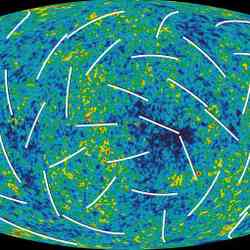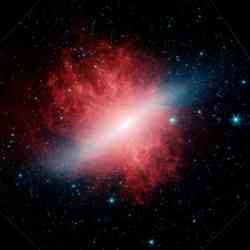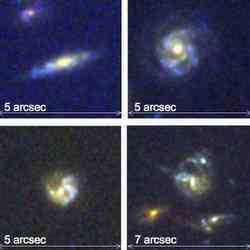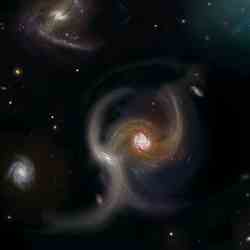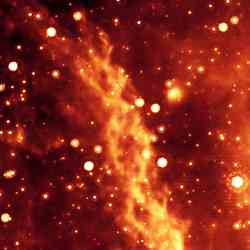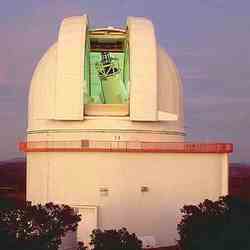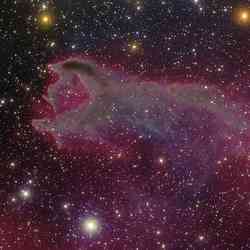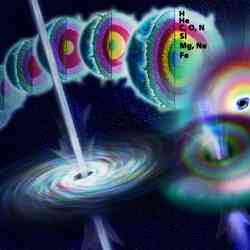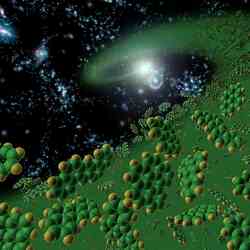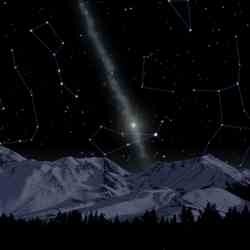
Artist’s illustration of the northern starry river. Image credit: Caltech Click to enlarge
Astronomers have found a narrow stream of stars extending across the sky for about 45 degrees – 90 times the width of the full Moon. The stream emanates from a cluster of 50,000 stars called NGC 5466, and stretches from Ursa Major (or the Big Dipper) to the constellation Bootes. The strength of gravity from the Milky Way is different on opposite sides of the star cluster, which causes it to stretch. Outlying stars are no longer held in the cluster and fall behind, creating the stream.
Astronomers have discovered a narrow stream of stars extending at least 45 degrees across the northern sky. The stream is about 76,000 light-years distant from Earth and forms a giant arc over the disk of the Milky Way galaxy.
In the March issue of the Astrophysical Journal Letters, Carl Grillmair, an associate research scientist at the California Institute of Technology’s Spitzer Science Center, and Roberta Johnson, a graduate student at California State University Long Beach, report on the discovery.
“We were blown away by just how long this thing is,” says Grillmair. “As one end of the stream clears the horizon this evening, the other will already be halfway up the sky.”
The stream begins just south of the bowl of the Big Dipper and continues in an almost straight line to a point about 12 degrees east of the bright star Arcturus in the constellation Bootes. The stream emanates from a cluster of about 50,000 stars known as NGC 5466.
The newly discovered stream extends both ahead and behind NGC 5466 in its orbit around the galaxy. This is due to a process called tidal stripping, which results when the force of the Milky Way’s gravity is markedly different from one side of the cluster to the other. This tends to stretch the cluster, which is normally almost spherical, along a line pointing towards the galactic center.
At some point, particularly when its orbit takes it close to the galactic center, the cluster can no longer hang onto its most outlying stars, and these stars drift off into orbits of their own. The lost stars that find themselves between the cluster and the galactic center begin to move slowly ahead of the cluster in its orbit, while the stars that drift outwards, away from the galactic center, fall slowly behind.
Ocean tides are caused by exactly the same phenomenon, though in this case it’s the difference in the moon’s gravity from one side of Earth to the other that stretches the oceans. If the gravity at the surface of Earth were very much weaker, then the oceans would be pulled from the planet, just like the stars in NGC 5466’s stream.
Despite its size, the stream has never previously been seen because it is so completely overwhelmed by the vast sea of foreground stars that make up the disk of the Milky Way. Grillmair and Johnson found the stream by examining the colors and brightnesses of more than nine million stars in the Sloan Digital Sky Survey public database.
“It turns out that, because they were all born at the same time and are situated at roughly the same distance, the stars in globular clusters have a fairly unique signature when you look at how their colors and brightnesses are distributed,” says Grillmair.
Using a technique called matched filtering, Grillmair and Johnson assigned to each star a probability that it might once have belonged to NGC 5466. By looking at the distribution of these probabilities across the sky, “the stream just sort of reached out and smacked us.
“The new stream may be even longer than we know, as we are limited at the southern end by the extent of the currently available data,” he adds. “Larger surveys in the future should be able to extend the known length of the stream substantially, possibly even right around the whole sky.”
The stars that make up the stream are much too faint to be seen by the unaided human eye. Owing to the vast distances involved, they are about three million times fainter than even the faintest stars that we can see on a clear night.
Grillmair says that such discoveries are important for our understanding of what makes up the Milky Way galaxy. Like earthbound rivers, such tidal streams can tell us which way is “down,” how steep is the slope, and where the mountains and valleys are located.
By measuring the positions and velocities of the stars in these streams, astronomers hope to determine how much Dark Matter the Milky Way contains, and whether the dark matter is distributed smoothly, or in enormous orbiting chunks.
Original Source: Caltech News Release

